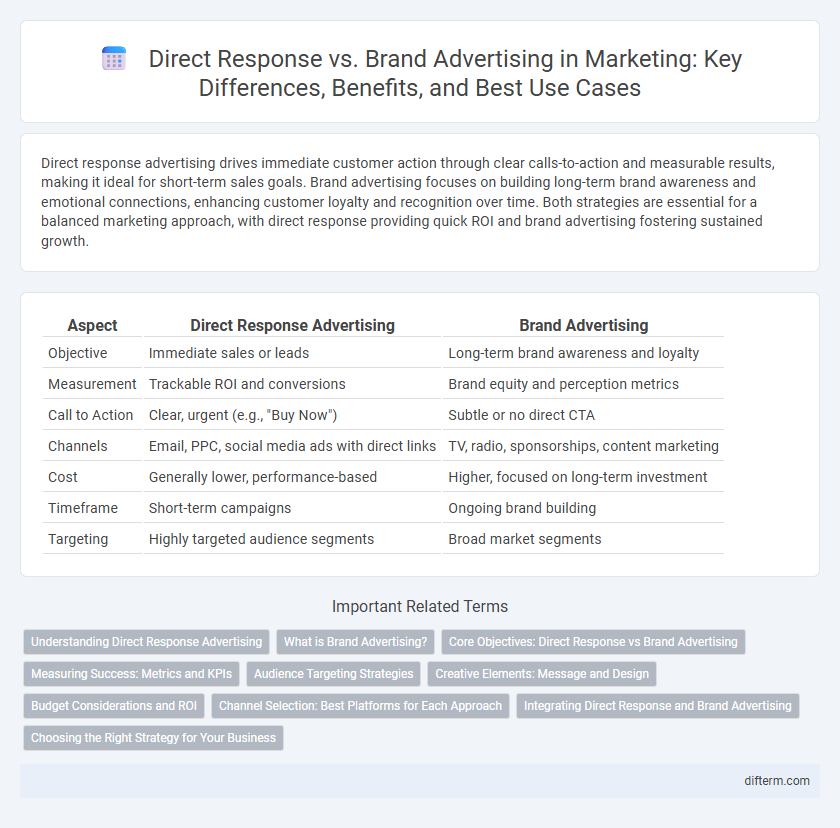Direct response advertising drives immediate customer action through clear calls-to-action and measurable results, making it ideal for short-term sales goals. Brand advertising focuses on building long-term brand awareness and emotional connections, enhancing customer loyalty and recognition over time. Both strategies are essential for a balanced marketing approach, with direct response providing quick ROI and brand advertising fostering sustained growth.
Table of Comparison
| Aspect | Direct Response Advertising | Brand Advertising |
|---|---|---|
| Objective | Immediate sales or leads | Long-term brand awareness and loyalty |
| Measurement | Trackable ROI and conversions | Brand equity and perception metrics |
| Call to Action | Clear, urgent (e.g., "Buy Now") | Subtle or no direct CTA |
| Channels | Email, PPC, social media ads with direct links | TV, radio, sponsorships, content marketing |
| Cost | Generally lower, performance-based | Higher, focused on long-term investment |
| Timeframe | Short-term campaigns | Ongoing brand building |
| Targeting | Highly targeted audience segments | Broad market segments |
Understanding Direct Response Advertising
Direct response advertising drives immediate action by targeting specific customer needs with clear calls-to-action, making performance measurement and ROI tracking straightforward. It uses channels like email, social media ads, and search engine marketing to generate leads, sales, or sign-ups quickly. This approach contrasts with brand advertising, which builds long-term awareness and loyalty without requiring an immediate response.
What is Brand Advertising?
Brand advertising focuses on building long-term customer awareness and loyalty by creating a strong, memorable brand identity and emotional connection. It emphasizes storytelling, consistent messaging, and visual elements to shape consumer perception and trust over time. Unlike direct response, brand advertising aims for brand recognition and preference rather than immediate sales conversions.
Core Objectives: Direct Response vs Brand Advertising
Direct response advertising targets immediate customer actions through measurable calls-to-action, optimizing conversions and sales within a short timeframe. Brand advertising aims to build long-term customer loyalty and brand equity by enhancing brand awareness, recognition, and emotional connection over extended periods. Core objectives differ as direct response focuses on quantifiable ROI, while brand advertising prioritizes sustained brand perception and market positioning.
Measuring Success: Metrics and KPIs
Direct response advertising measures success through immediate KPIs like click-through rates, conversion rates, and return on ad spend (ROAS), enabling precise tracking of campaign effectiveness. Brand advertising focuses on long-term metrics such as brand awareness, brand recall, and customer sentiment, often assessed through surveys and social listening tools. Combining these metrics provides a comprehensive view of marketing impact, balancing short-term sales performance with long-term brand equity growth.
Audience Targeting Strategies
Direct response advertising employs precise audience targeting strategies by leveraging data analytics and behavior tracking to deliver personalized messages that prompt immediate action. Brand advertising focuses on broader demographic and psychographic profiling to build long-term relationships by creating emotional connections and enhancing brand recognition. Utilizing AI-driven algorithms and CRM insights improves audience segmentation effectiveness in both approaches, optimizing campaign performance and ROI.
Creative Elements: Message and Design
Direct response advertising employs concise, action-oriented messages with bold, clear design elements that drive immediate consumer engagement and measurable outcomes. Brand advertising emphasizes storytelling through emotionally resonant messaging and visually cohesive, aesthetically appealing designs to build long-term brand identity and loyalty. Effective integration of targeted calls-to-action within direct response campaigns contrasts with the consistent visual themes and narrative arcs central to brand advertising's creative strategy.
Budget Considerations and ROI
Direct response advertising allocates budget toward measurable, immediate results, often yielding higher ROI through precise targeting and performance tracking. Brand advertising requires sustained investment with longer-term budget commitments, focusing on awareness and customer loyalty rather than instant conversions. Marketers must balance short-term ROI from direct response with the enduring value generated by brand-building efforts to optimize overall budget efficiency.
Channel Selection: Best Platforms for Each Approach
Direct response marketing excels on platforms such as Facebook Ads, Google Ads, and email campaigns where precise targeting and measurable conversions drive immediate action. Brand advertising finds optimal impact on mass reach channels like TV, YouTube, and Instagram Stories, which build long-term awareness and emotional connections. Selecting the right channel depends on campaign goals: direct response demands platforms with strong call-to-action features, while brand advertising thrives where storytelling and broad audience engagement are possible.
Integrating Direct Response and Brand Advertising
Integrating direct response and brand advertising maximizes marketing effectiveness by combining immediate customer action with long-term brand equity growth. Data-driven direct response campaigns provide measurable ROI, while brand advertising builds trust and emotional connections that increase customer lifetime value. A unified strategy leverages both to enhance overall conversion rates and sustain competitive advantage.
Choosing the Right Strategy for Your Business
Direct response advertising drives immediate customer actions through measurable calls-to-action, making it ideal for businesses seeking quick sales or lead generation. Brand advertising builds long-term awareness and emotional connections, essential for companies aiming to establish market presence and customer loyalty. Evaluating your business goals, target audience, and budget ensures the most effective strategy choice between direct response and brand advertising.
Direct response vs brand advertising Infographic

 difterm.com
difterm.com